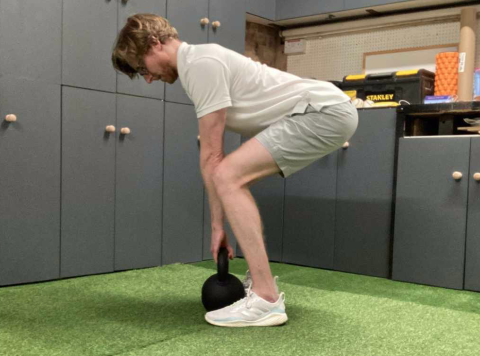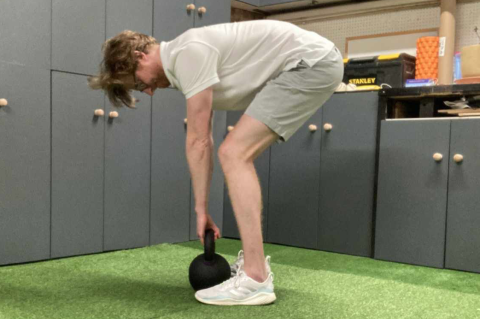3 common kettlebell mistakes
27th May 2021 - 13:26 ">
Jon Hodgkinson explains how to avoid these three common mistakes when exercising with kettlebells, as featured in 220 Triathlon Magazine.
1. Open Chain Vs Closed Chain Kettlebell Swings.
Correct technique is an important factor when you start loading up exercises with additional weight and attempt to exert more force and power. The smallest of movement discrepancies will be exposed and risk injuries occurring.
With this in mind making sure your body is set up in a closed circuit (as shown in the image below) with your spine stable and braced, hips and shoulders stable is key.

One of the most common mistakes I see is the ‘open circuit’ set up position. Put simply this is often displayed by the body being in a poor position at address, with a rounded back and shoulders and hips hiking up into the air (see below).

Not only will this put more stress on the vertebrae of the spine and risk injury, it also means that due to the lack of tension created in muscles you will generate less force and power when completing a KB Swing.
To fix the issue try this hip hinge drill that teaches you the body positions of the hips, spine and shoulders so you have the body awareness before moving on to the KB swing.
Instructions:
Set up with a dowel or broom handle placed in line with your spine, hips and head.
Soften the knees slightly in to a ¼ squat position with your feet set at shoulder width.
Drive your hips backwards whilst bringing your upper body forwards, keeping the dowel in contact with your hips, spine and head throughout. This should create tension in the glutes and hamstrings.
Drive your hips back through extending up in to a tall standing position.
Focus on bracing your abdominals throughout the whole movement.
When you have this drill moving well progress onto a light KB and progressively build up in weight.
2. Momentum controlling your foot position.
This is often seen in the KB swing when people first start out.
The action of a KB swing brings the weight out in front of the body during its arching movement pathway
If you don’t have a solid stance with your feet driving down into the floor it’s easy for the momentum of this movement to shift your weight forwards into the balls of the feet bringing your heels up from the ground and creating an unstable and uncontrolled movement.
This will often lead to an over compensation with you having to re-establish your foot position and can create issues with load on the spine, which is not ideal.
To fix this issue focus simply on creating tension through the lower body by “screwing” your feet into the floor and ensuring the KB swing remains a hip-based movement with little involvement from the knees.
Imagine you are stood on 2 dinner plates, one under each foot, the “screwing” action rotates the plates slightly as you dig into the ground. Done correctly you’ll feel the thighs tighten up a little and the glutes kick in.
3. Going too heavy too soon.
As with any exercise it is important that you work on developing good technique and adequate range of motion before either adding weight or increasing the weight you lift.
This stands true for all of the above-mentioned exercises and somewhat more importantly for those that focus on unilateral (single-leg) movements.
If you go too heavy on the Single-leg Deadlift and start to round through the spine then you are losing the emphasis of being able to work on using your glutes and hamstrings to generate hip extension and instead will be using your back muscles to complete the movement.
The same would be true for the balance aspects of these movements too…. sometimes having a little bit more weight can help as a counter-balance but there’s a fine line between having enough weight to help you balance and too much weight pulling you off balance. It’s up to you to make sure your technique is good on these movements before increasing weight.
How to train with a Kettlebell
As strength endurance is a key attribute for triathlon it makes sense to build your kettlebell training into a programme that helps to develop this particular attribute.
Following the NASM periodisation model for strength endurance this is what a running based kettlebell workout might look like…
|
Exercise |
Sets |
Repetitions |
Rest |
Tempo |
|
Offset Reverse Lunge Knee Drive |
2-3 |
10-12 each side |
Up to 60 seconds |
2-0-2 |
|
Supine Leg Lowering |
2-3 |
10-12 each side |
Up to 60 seconds |
3-0-3 |
|
Single Leg Deadlift |
2-3 |
10-12 each side |
Up to 60 seconds |
3-0-3 |
|
Multiplanar Lunges |
2-3 |
10-12 each side |
Up to 60 seconds |
2-0-2 |
|
KB Swing |
5-6 |
8 |
Up to 60 seconds |
Explosive |
Training notes:
Start by completing 2 sets of 10 repetitions on the first 4 exercises then over time build up to 2 sets of 12 repetitions. Your next progression is to complete 3 sets of 10 repetitions then build to 3 sets of 12 repetitions. Then increase your weight.
The tempo refers to the number of seconds you lower into each movement (2 or 3 seconds) then 0 seconds pause before driving back up for the same number of seconds.
For example, on the Reverse Lunge Knee Drive – Step back and lower your back knee down towards the ground for 2 seconds, then without any pause at the bottom of the movement drive back up into a knee drive at a 2 second tempo.
Keep KB swings on the lower repetition range of 8 but work on the explosive hip hinge to develop power in the hip extension phase.